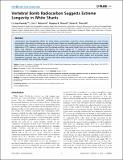| dc.contributor.author | Hamady, Li Ling | |
| dc.contributor.author | Natanson, Lisa J. | |
| dc.contributor.author | Skomal, Gregory B. | |
| dc.contributor.author | Thorrold, Simon R. | |
| dc.date.accessioned | 2014-04-09T19:30:00Z | |
| dc.date.available | 2014-04-09T19:30:00Z | |
| dc.date.issued | 2014-01 | |
| dc.date.submitted | 2013-08 | |
| dc.identifier.issn | 1932-6203 | |
| dc.identifier.uri | http://hdl.handle.net/1721.1/86085 | |
| dc.description.abstract | Conservation and management efforts for white sharks (Carcharodon carcharias) remain hampered by a lack of basic demographic information including age and growth rates. Sharks are typically aged by counting growth bands sequentially deposited in their vertebrae, but the assumption of annual deposition of these band pairs requires testing. We compared radiocarbon (Δ14C) values in vertebrae from four female and four male white sharks from the northwestern Atlantic Ocean (NWA) with reference chronologies documenting the marine uptake of 14C produced by atmospheric testing of thermonuclear devices to generate the first radiocarbon age estimates for adult white sharks. Age estimates were up to 40 years old for the largest female (fork length [FL]: 526 cm) and 73 years old for the largest male (FL: 493 cm). Our results dramatically extend the maximum age and longevity of white sharks compared to earlier studies, hint at possible sexual dimorphism in growth rates, and raise concerns that white shark populations are considerably more sensitive to human-induced mortality than previously thought. | en_US |
| dc.language.iso | en_US | |
| dc.publisher | Public Library of Science | en_US |
| dc.relation.isversionof | http://dx.doi.org/10.1371/journal.pone.0084006 | en_US |
| dc.rights | Creative Commons Attribution | en_US |
| dc.rights.uri | http://creativecommons.org/licenses/by/4.0/ | en_US |
| dc.source | PLoS | en_US |
| dc.title | Vertebral Bomb Radiocarbon Suggests Extreme Longevity in White Sharks | en_US |
| dc.type | Article | en_US |
| dc.identifier.citation | Hamady, Li Ling, Lisa J. Natanson, Gregory B. Skomal, and Simon R. Thorrold. “Vertebral Bomb Radiocarbon Suggests Extreme Longevity in White Sharks.” Edited by Christopher J. Fulton. PLoS ONE 9, no. 1 (January 8, 2014): e84006. | en_US |
| dc.contributor.department | Woods Hole Oceanographic Institution | en_US |
| dc.contributor.mitauthor | Hamady, Li Ling | en_US |
| dc.relation.journal | PLoS ONE | en_US |
| dc.eprint.version | Final published version | en_US |
| dc.type.uri | http://purl.org/eprint/type/JournalArticle | en_US |
| eprint.status | http://purl.org/eprint/status/PeerReviewed | en_US |
| dspace.orderedauthors | Hamady, Li Ling; Natanson, Lisa J.; Skomal, Gregory B.; Thorrold, Simon R. | en_US |
| mit.license | PUBLISHER_CC | en_US |
| mit.metadata.status | Complete | |
